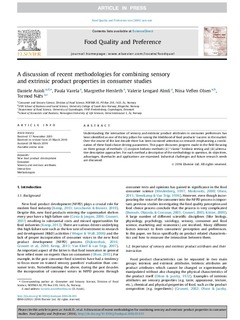| dc.contributor.author | Asioli, Daniele | |
| dc.contributor.author | Varela, Paula | |
| dc.contributor.author | Hersleth, Margrethe | |
| dc.contributor.author | Almli, Valerie Lengard | |
| dc.contributor.author | Olsen, Nina Veflen | |
| dc.contributor.author | Næs, Tormod | |
| dc.date.accessioned | 2016-11-16T10:16:02Z | |
| dc.date.accessioned | 2016-11-18T12:04:15Z | |
| dc.date.available | 2016-11-16T10:16:02Z | |
| dc.date.available | 2016-11-18T12:04:15Z | |
| dc.date.issued | 2016 | |
| dc.identifier.citation | Food Quality and Preference 2016 | |
| dc.identifier.issn | 0950-3293 | |
| dc.identifier.uri | http://hdl.handle.net/11250/2421827 | |
| dc.description | - | |
| dc.description.abstract | Understanding the interaction of sensory and extrinsic product attributes in consumer preferences has been identified as one of the key pillars for raising the likelihood of food products’ success in the market. Over the course of the last decade there has been increased attention on research emphasizing a combination of these food-choice driving parameters. This paper discusses progress made in the field focusing on three groups of methods: (i) conjoint hedonic methods (ii) “classic” hedonic testing and (iii) alternative descriptive approaches. For each method a description of the methodology in question, its objectives, advantages, drawbacks and applications are examined. Industrial challenges and future research needs are discussed. | |
| dc.language.iso | eng | |
| dc.title | A discussion of recent methodologies for combining sensory and extrinsic product properties in consumer studies | |
| dc.type | Journal article | |
| dc.date.updated | 2016-11-16T10:16:02Z | |
| dc.identifier.doi | 10.1016/j.foodqual.2016.03.015 | |
| dc.identifier.cristin | 1352749 | |
| dc.relation.project | Nofima AS: 201308 | |
| dc.relation.project | Norges forskningsråd: 225062 | |
| dc.relation.project | Nofima AS: 201302 | |
| dc.relation.project | Norges forskningsråd: 225096 | |
| dc.relation.project | Norges forskningsråd: 233684 | |
| dc.relation.project | Nofima AS: 10841 | |
| dc.relation.project | Nofima AS: 10848 | |
